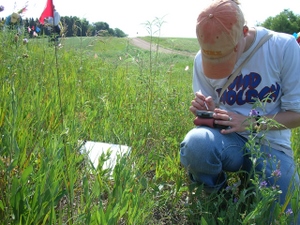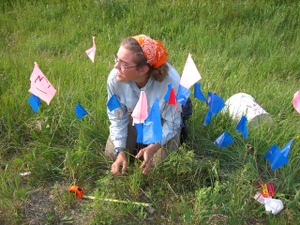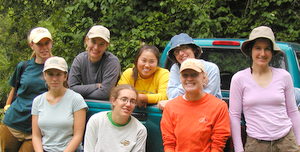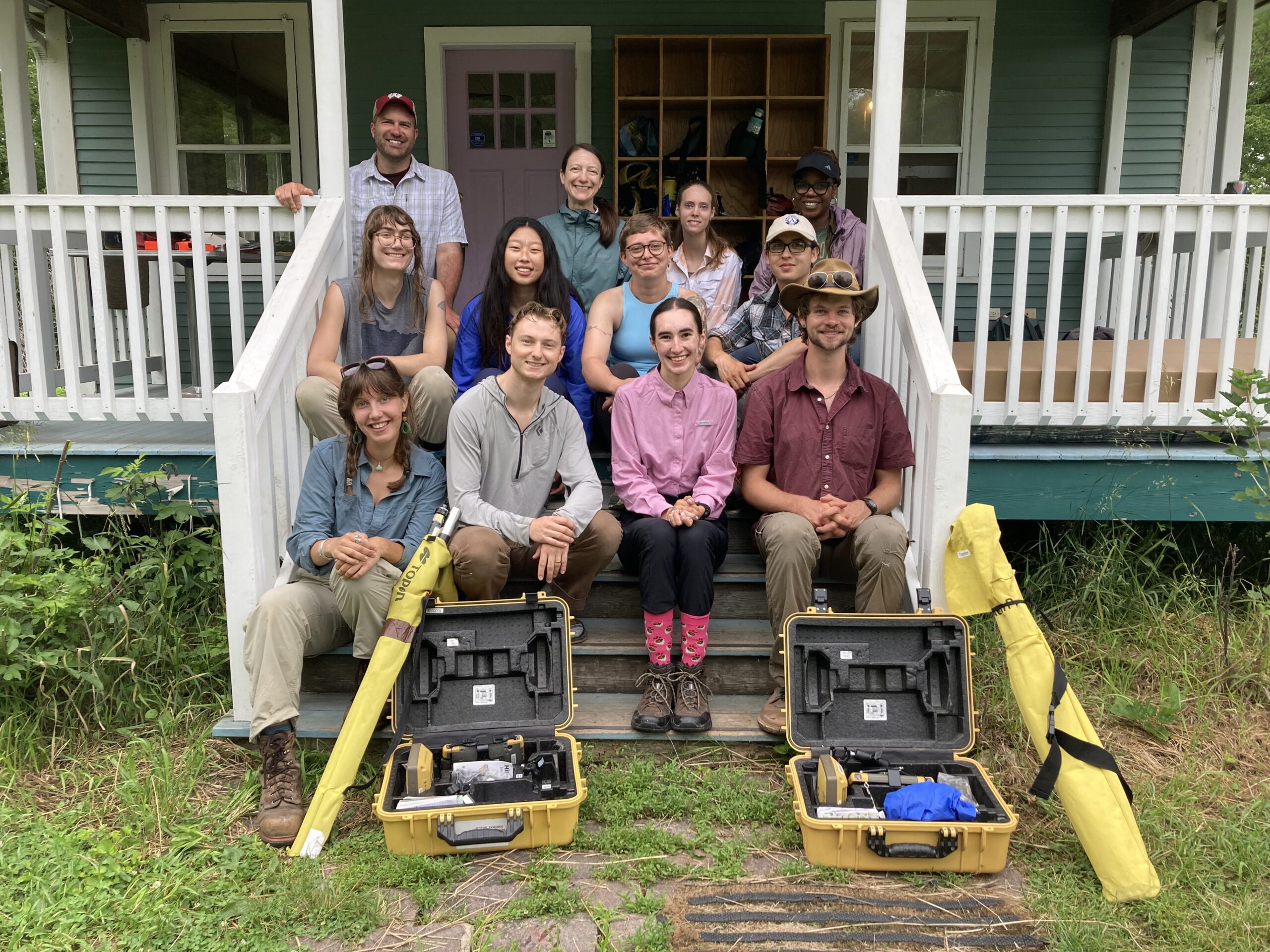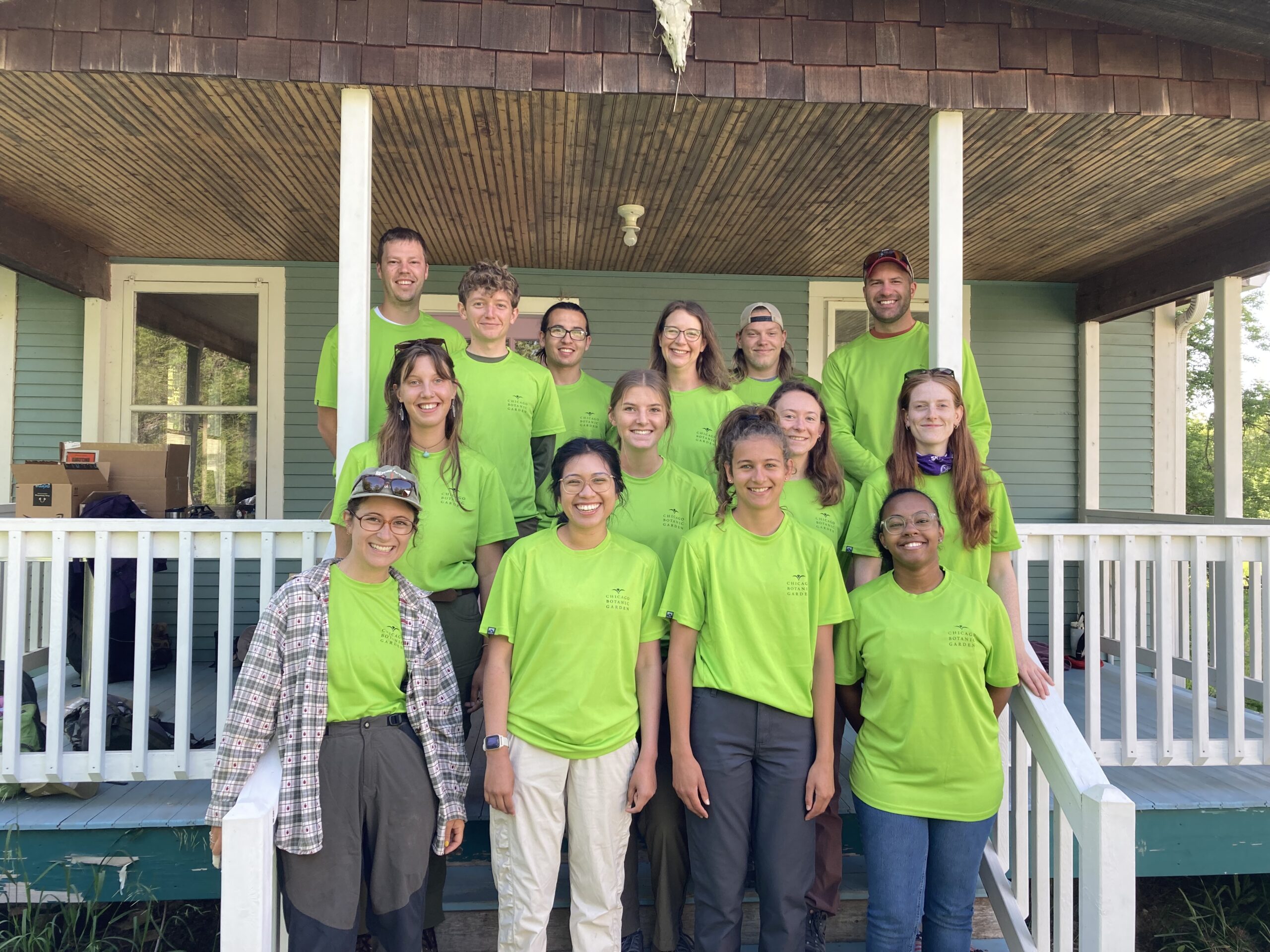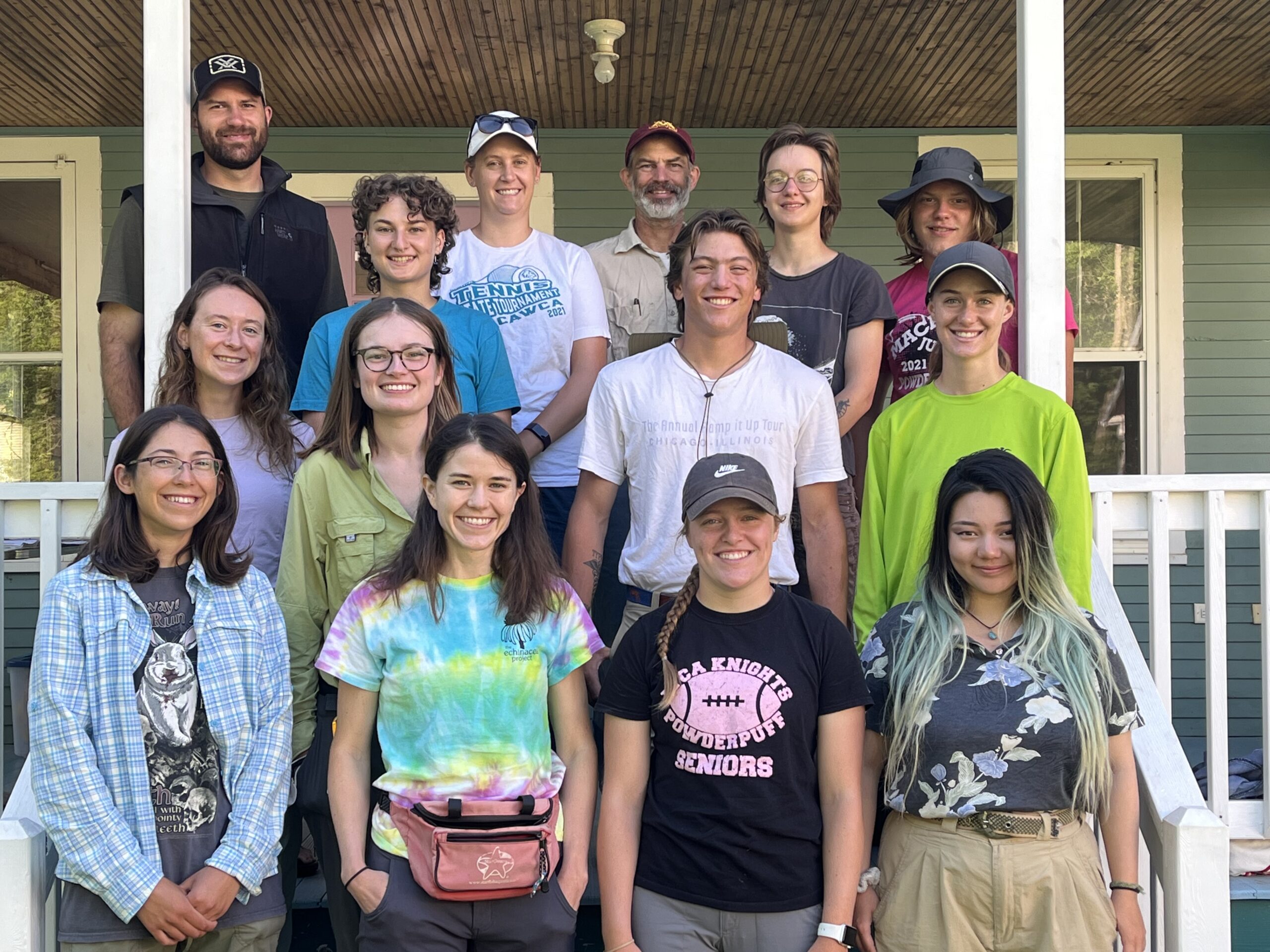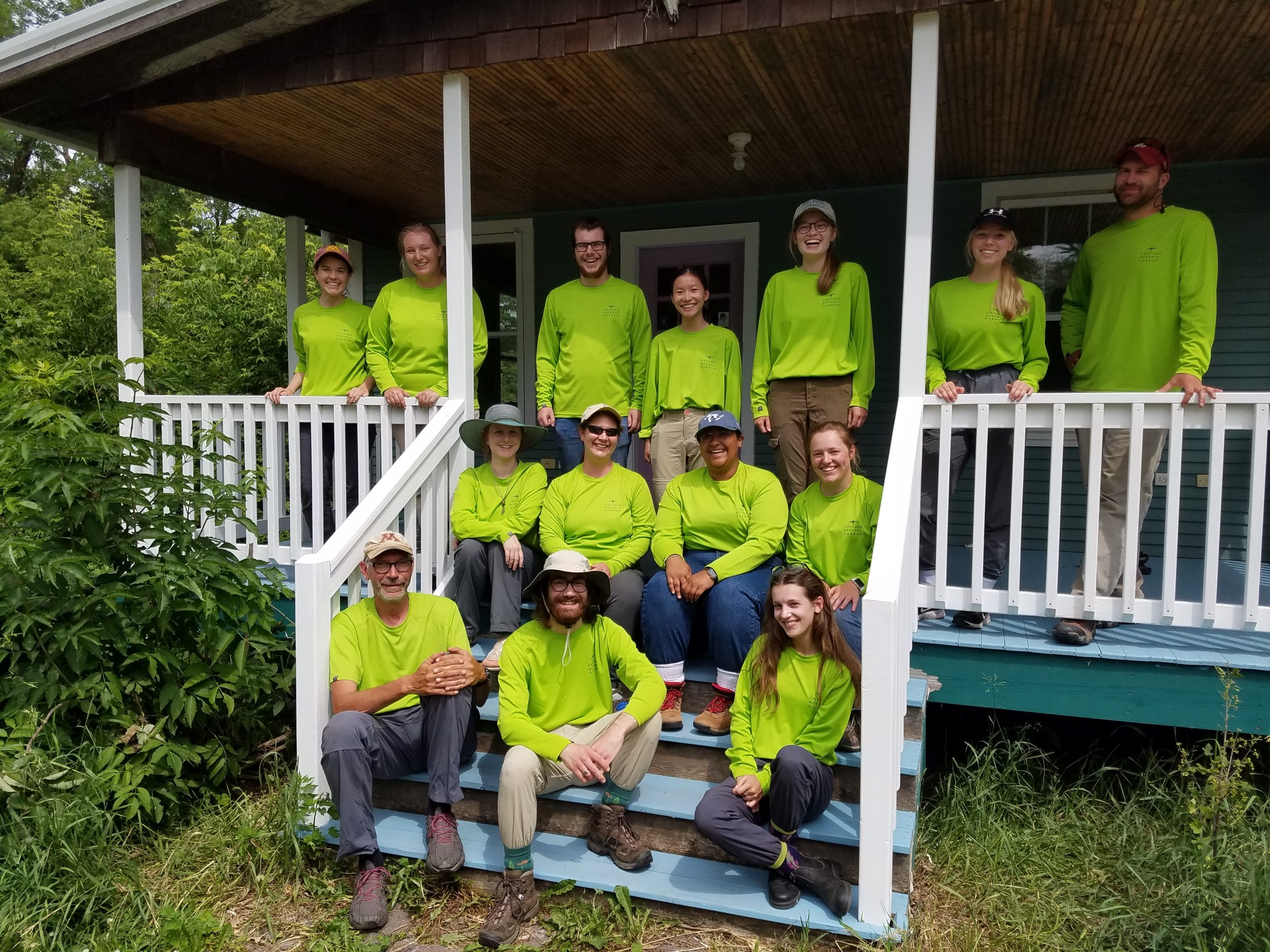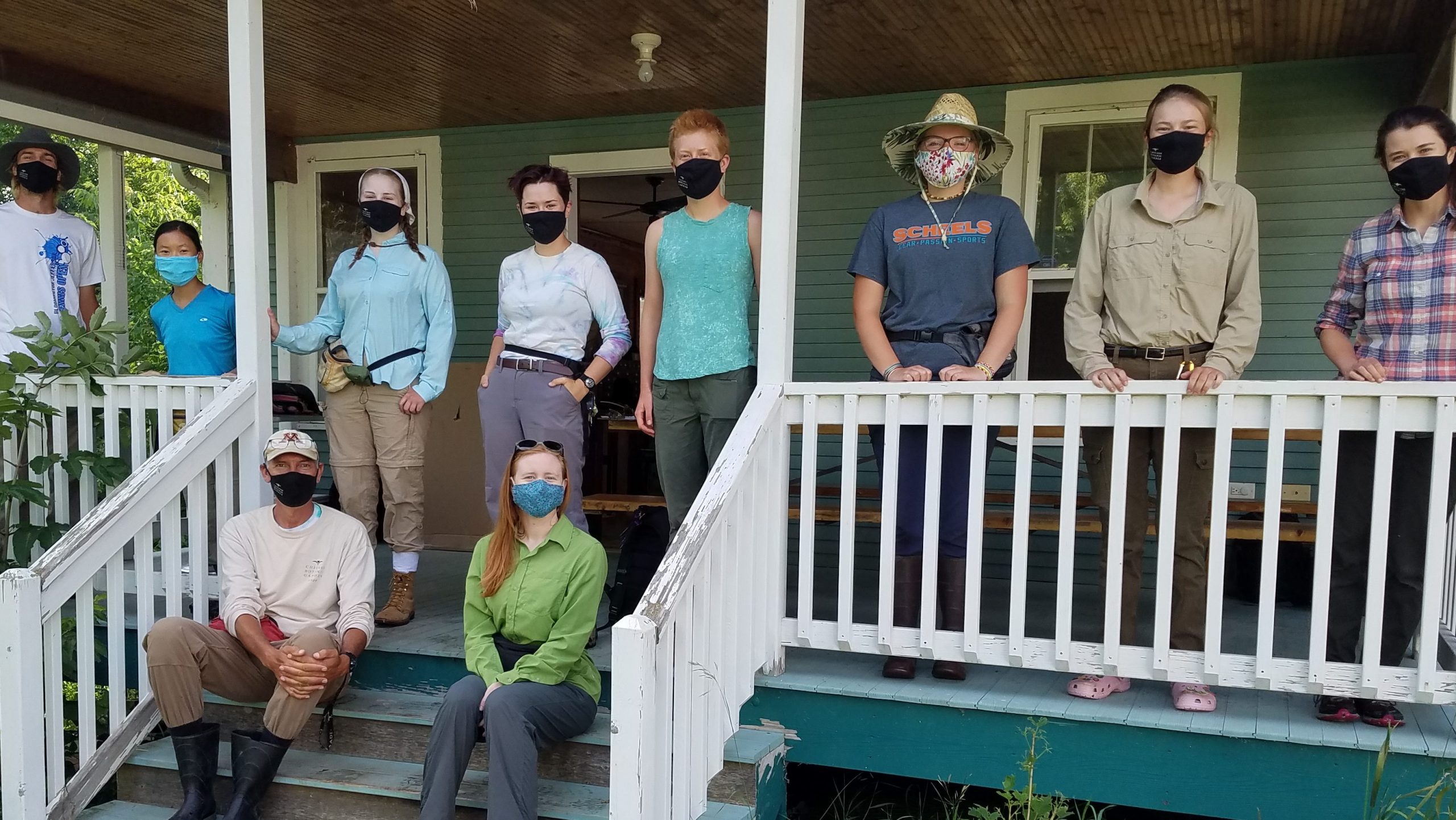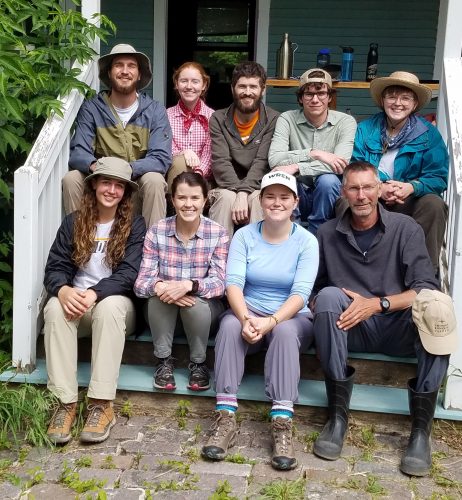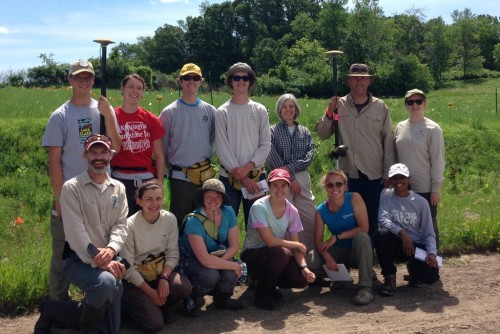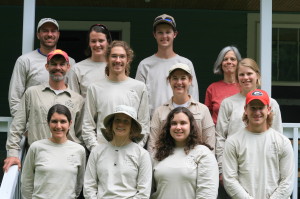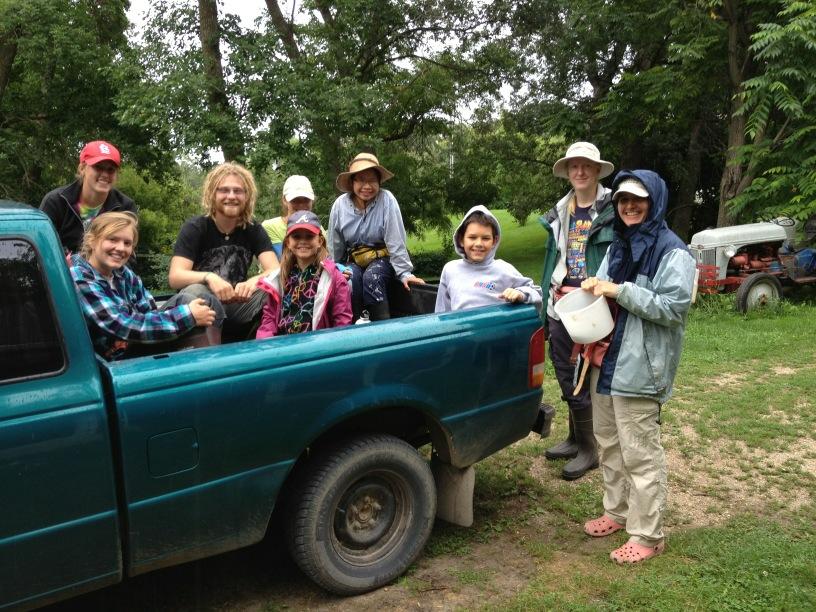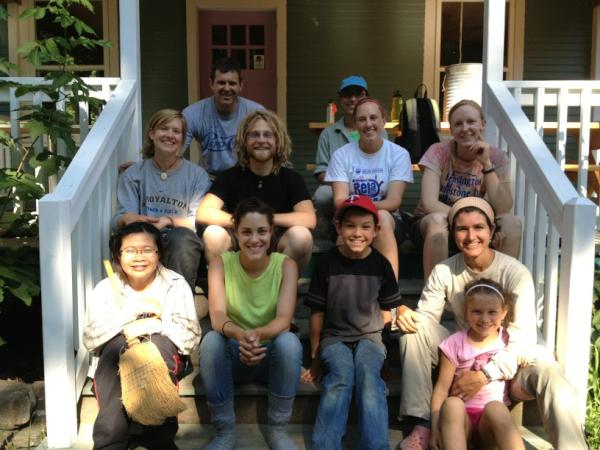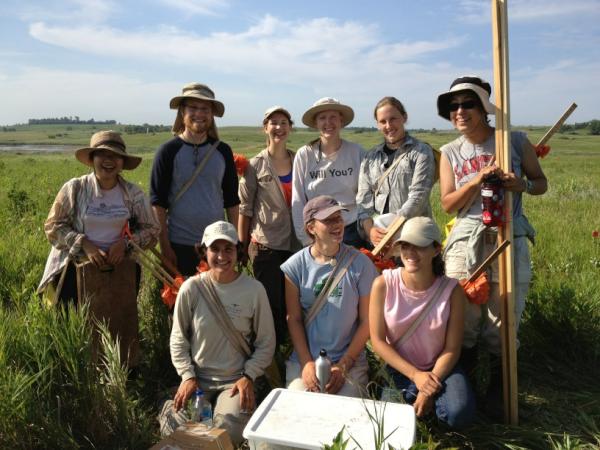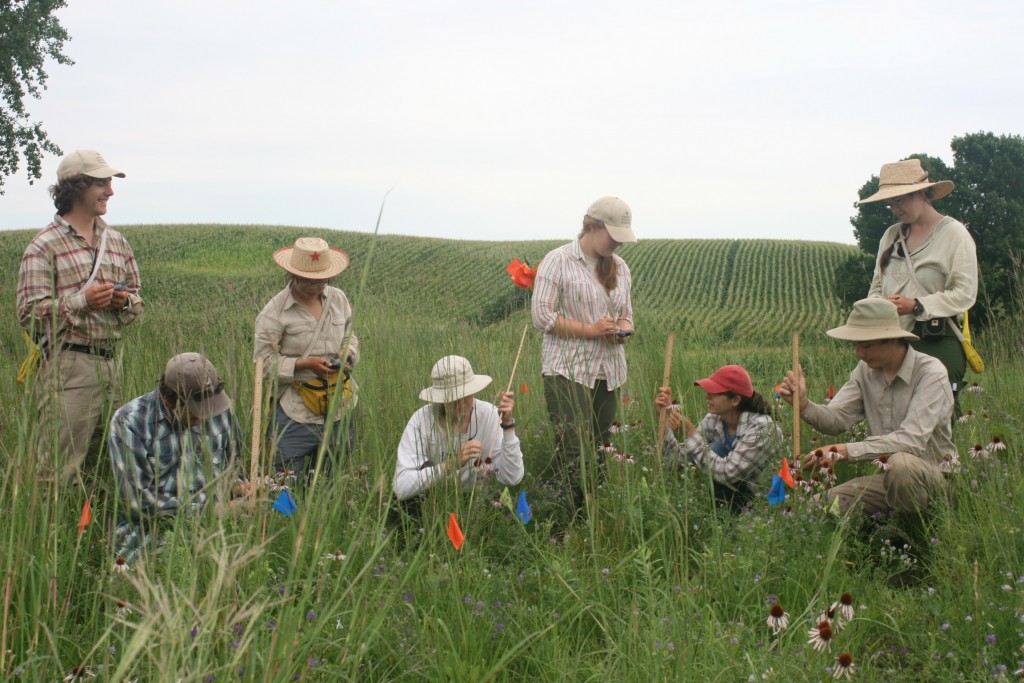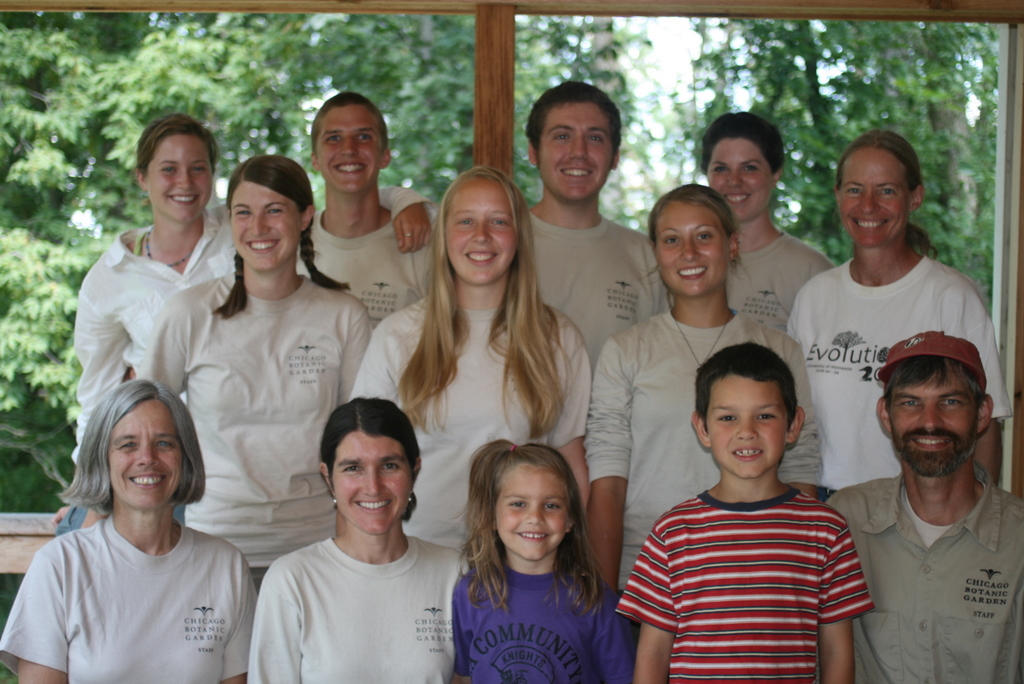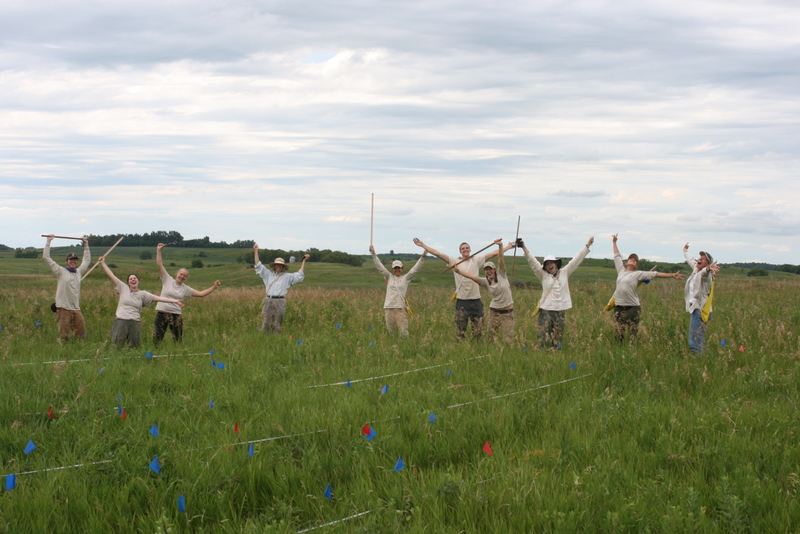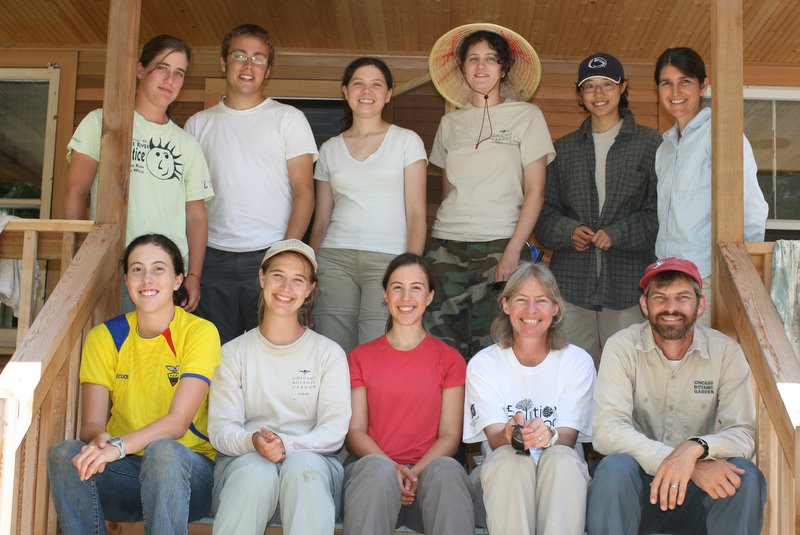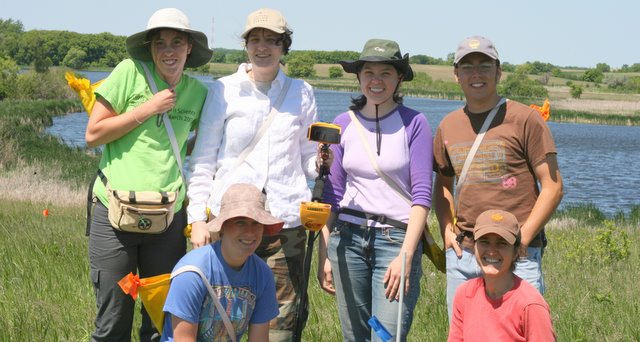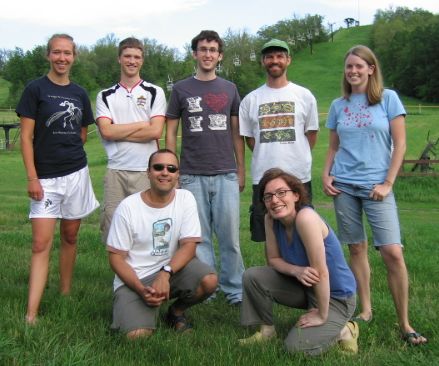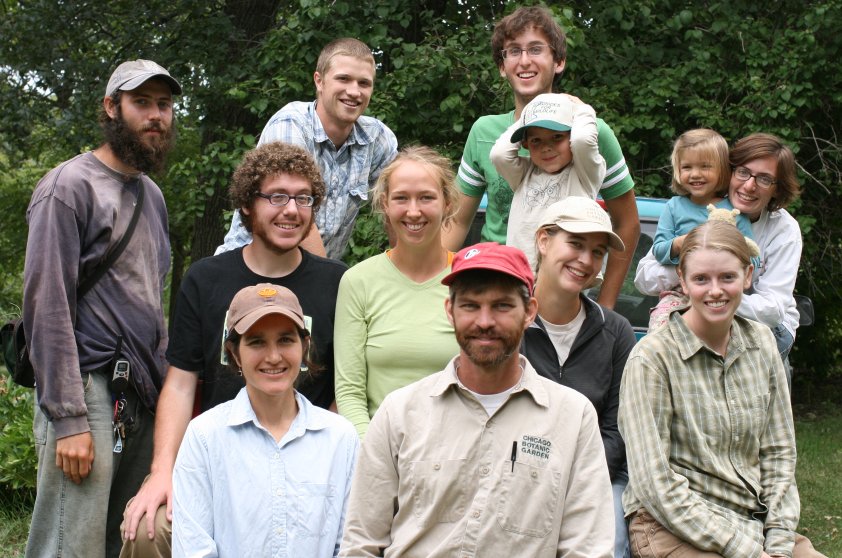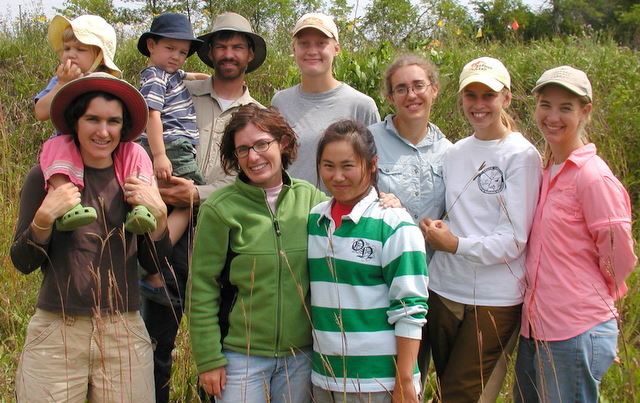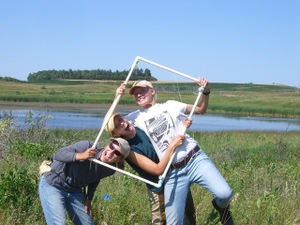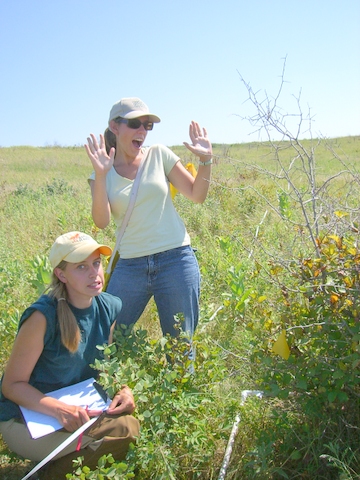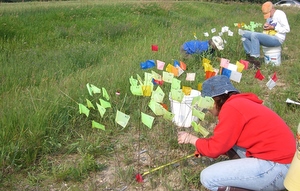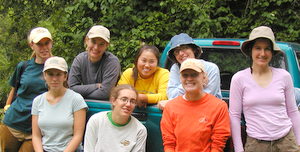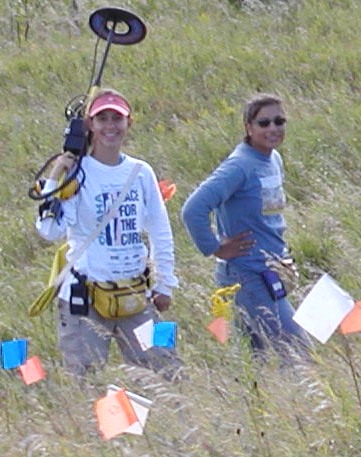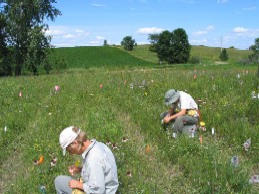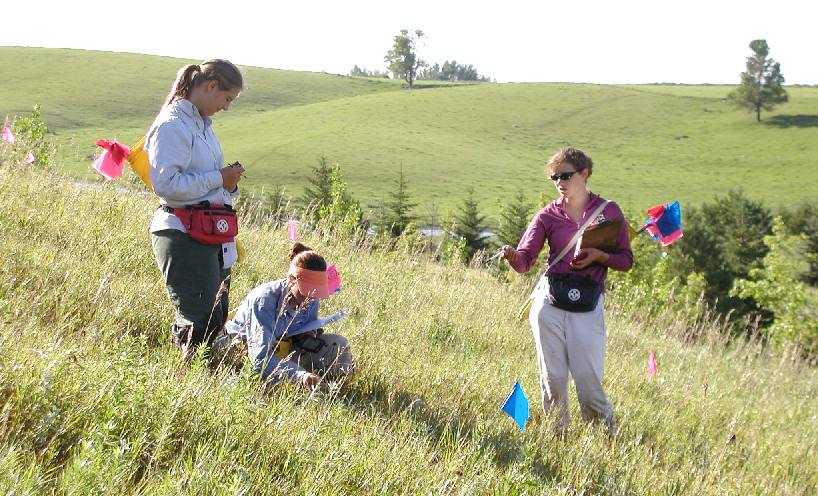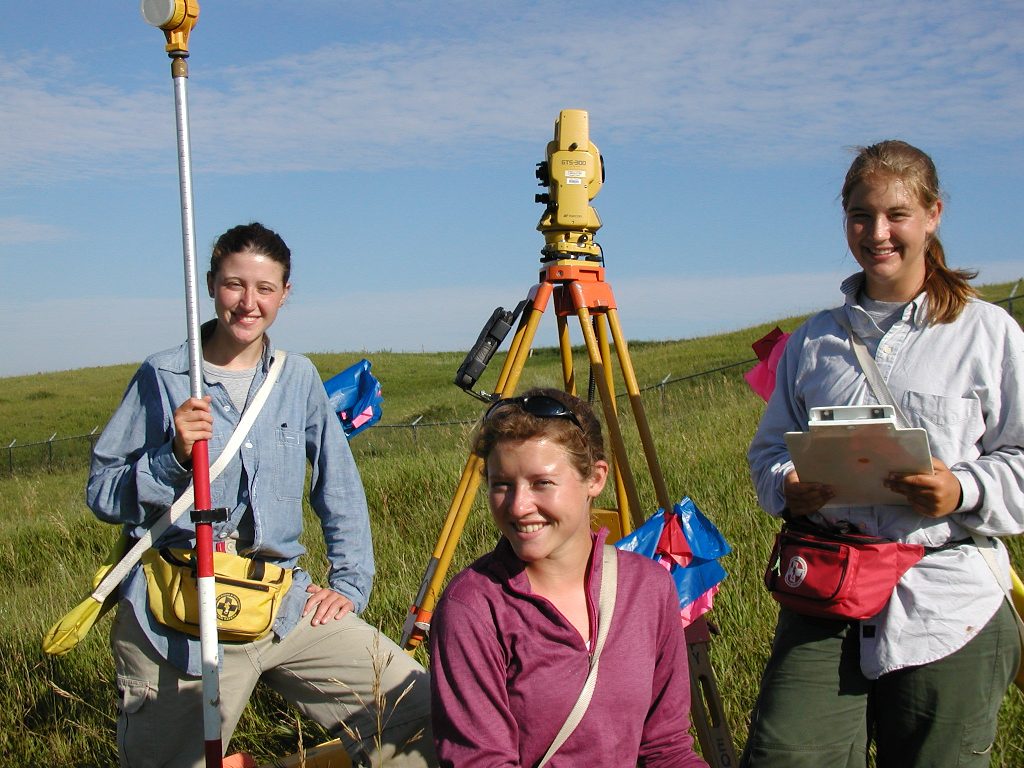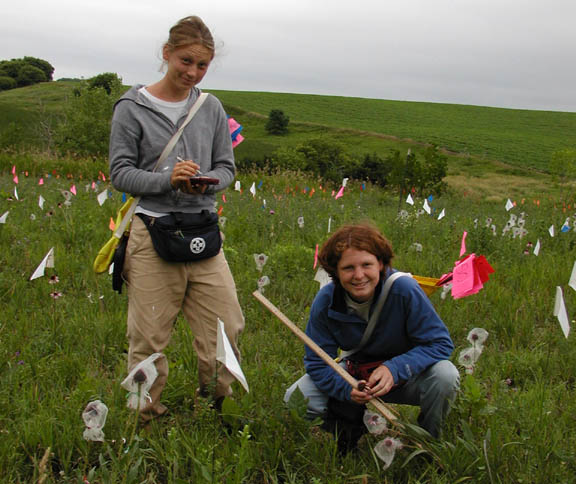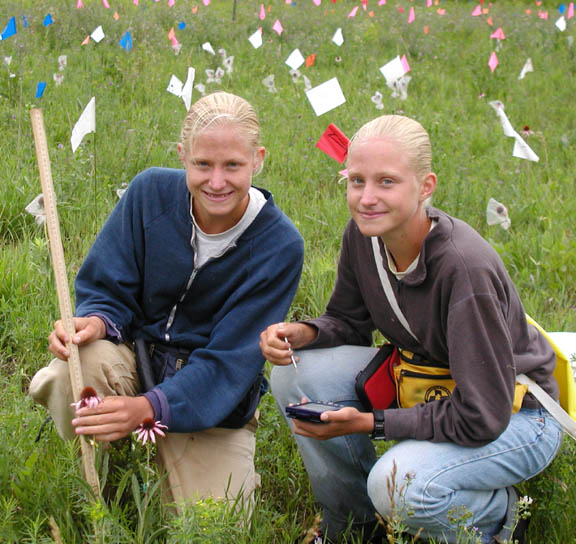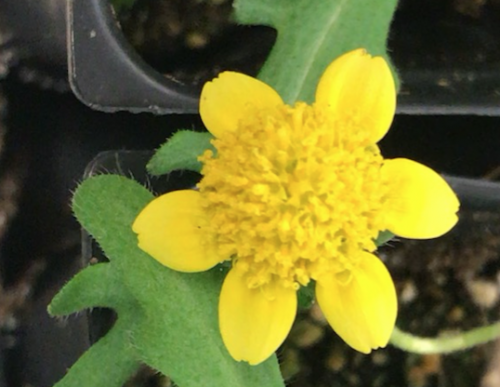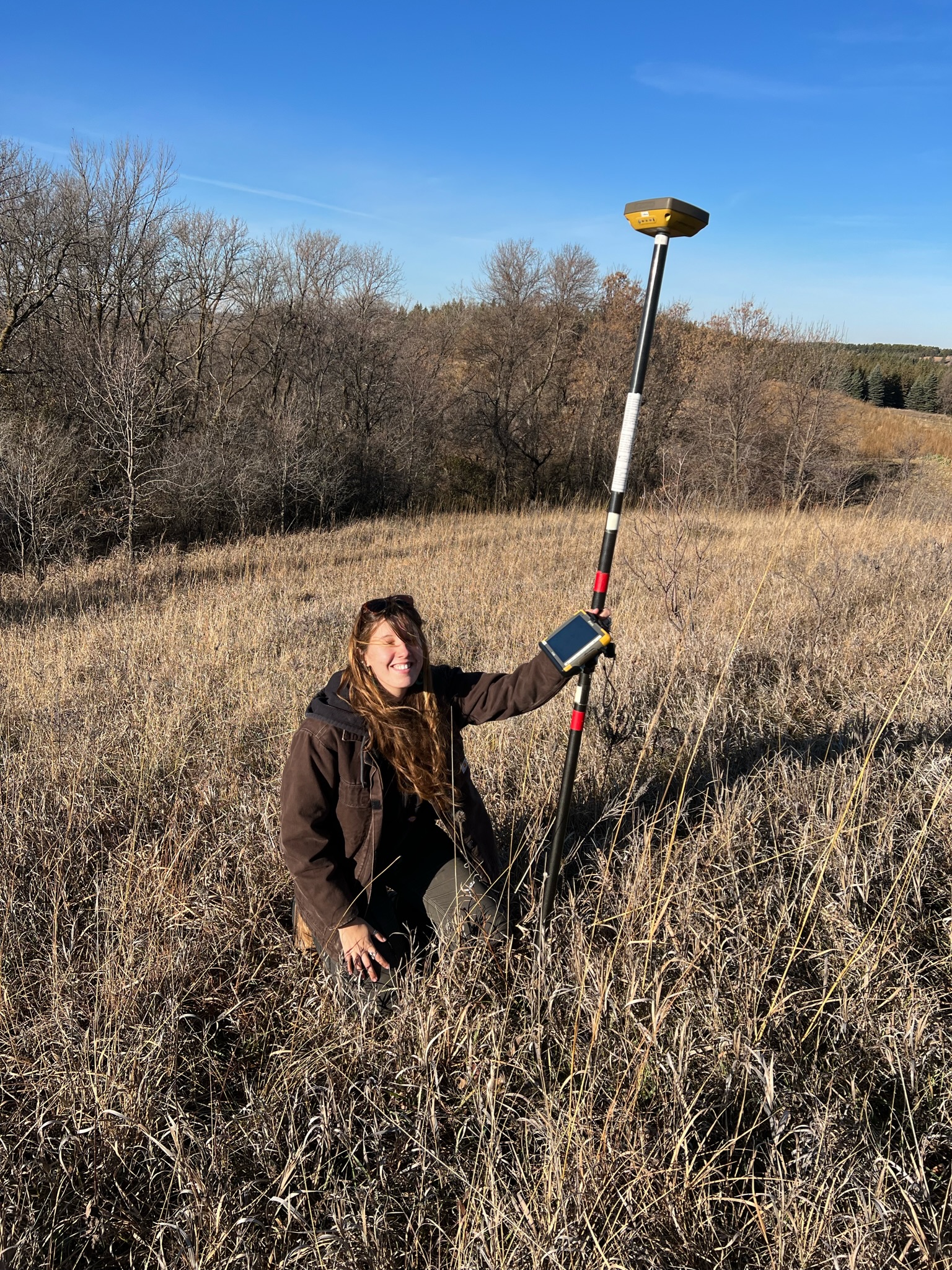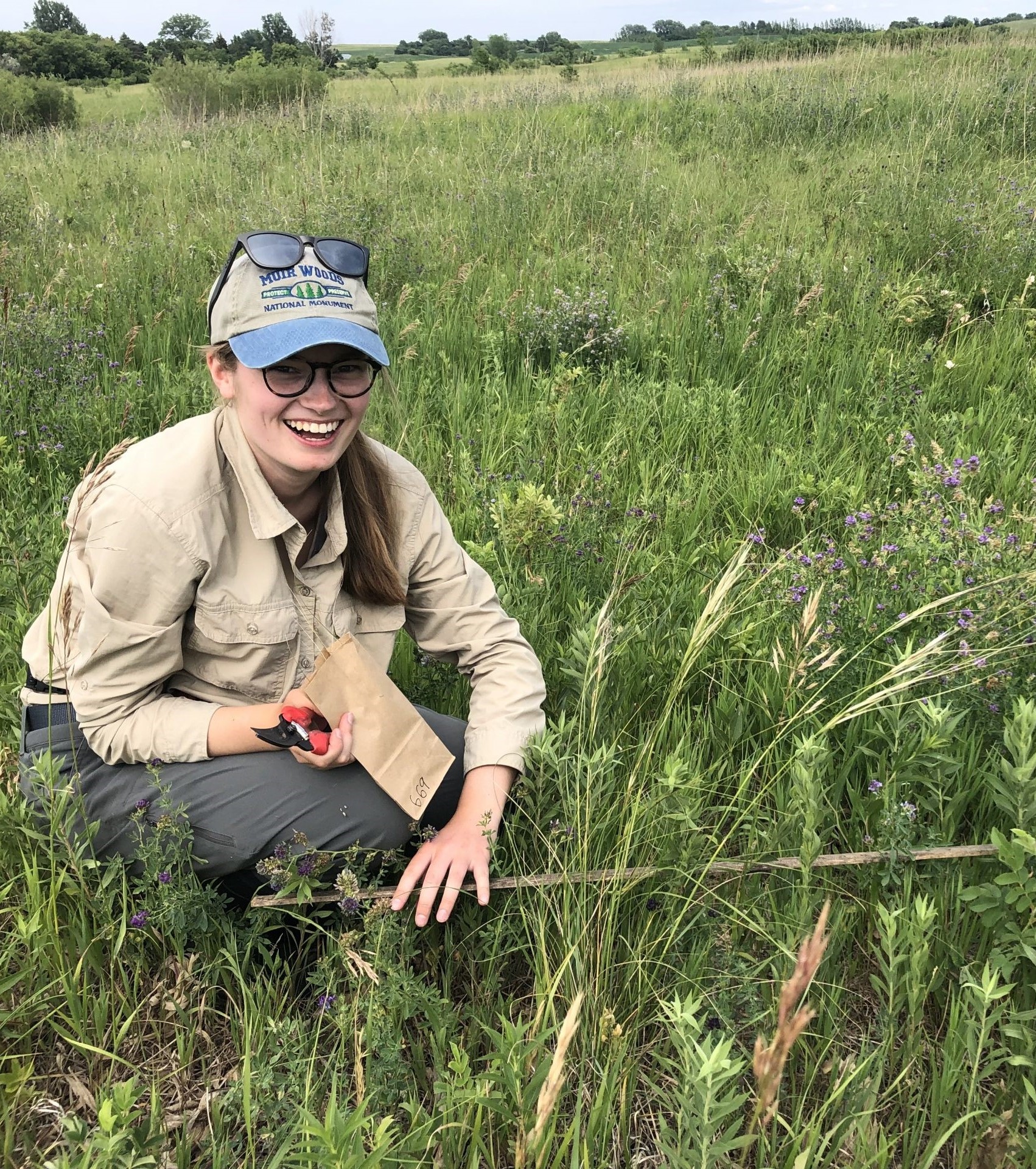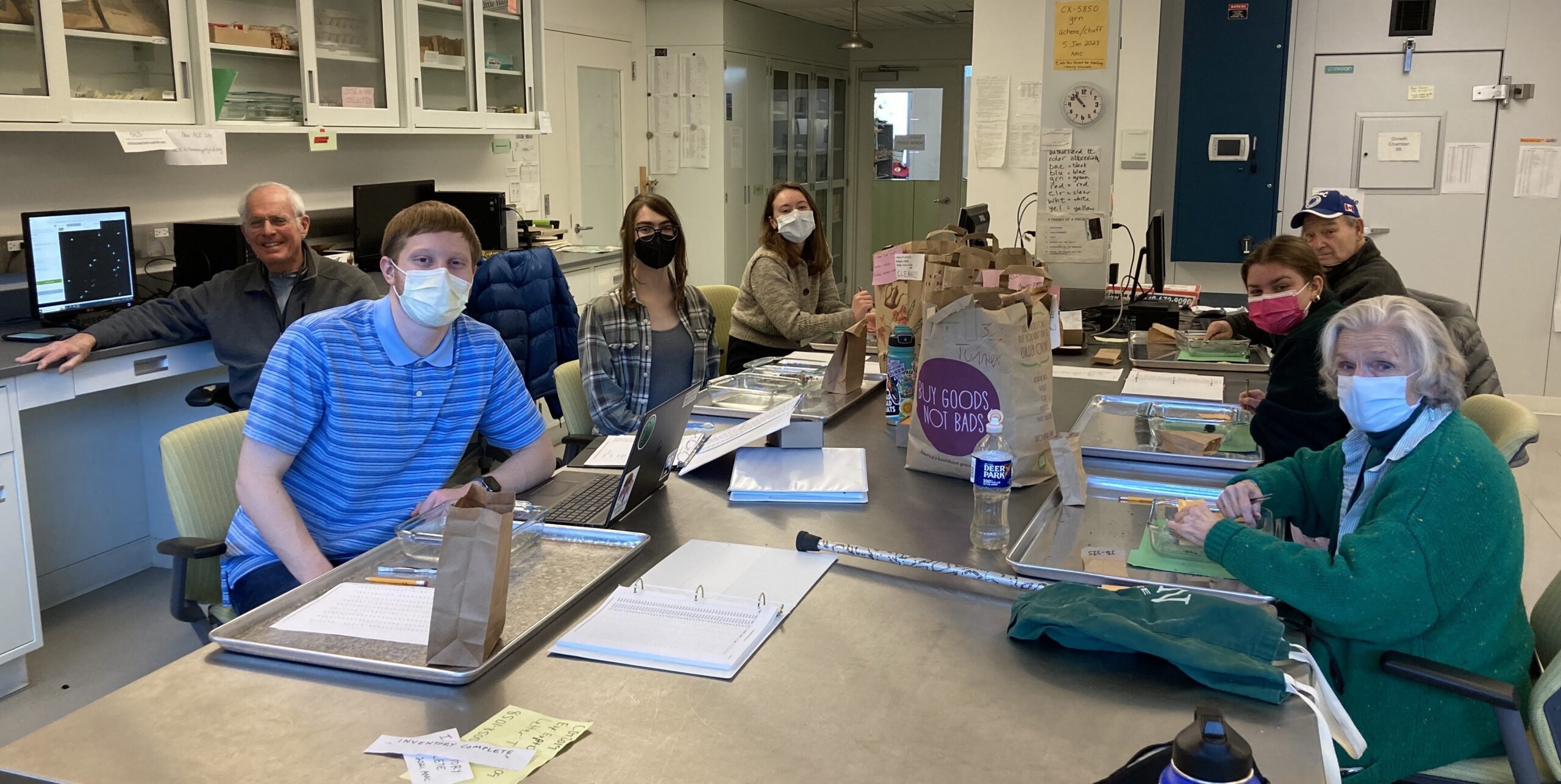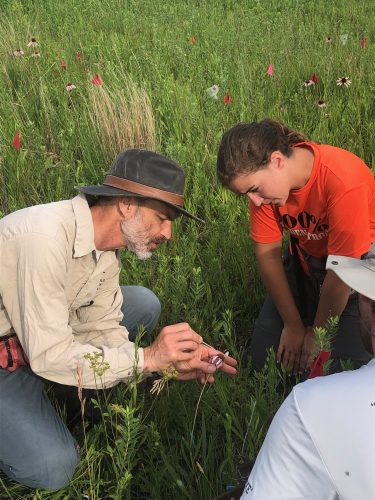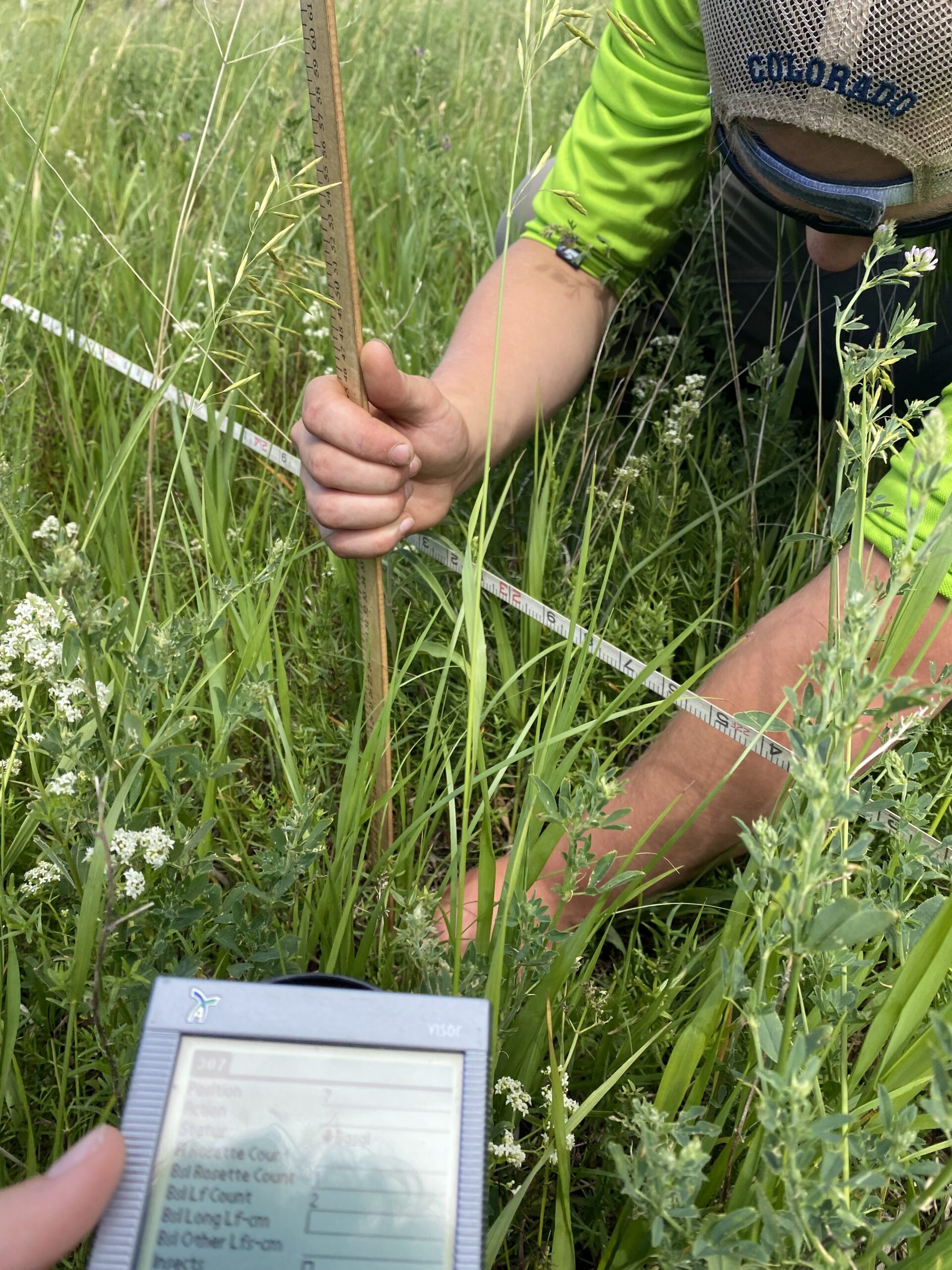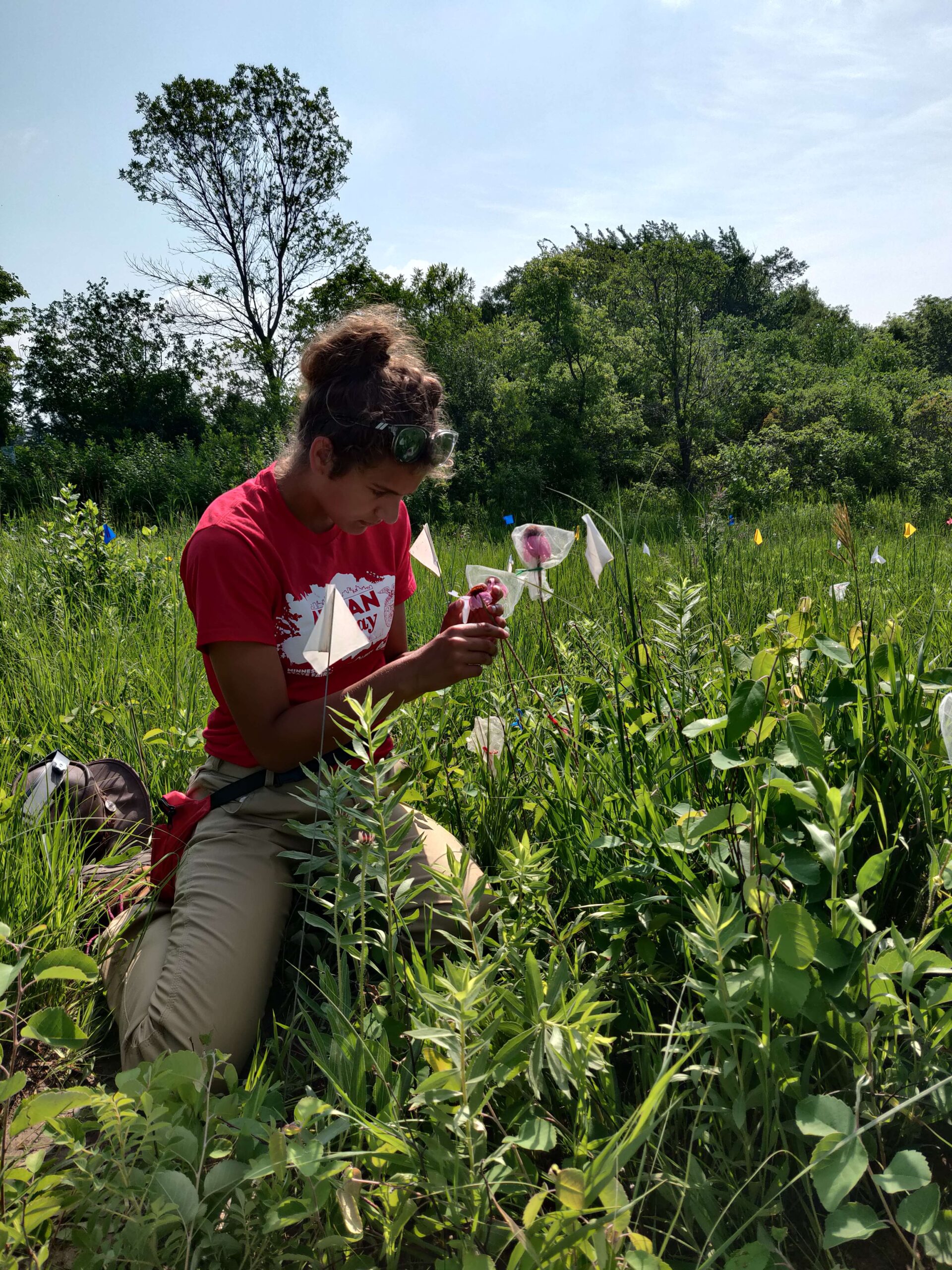|
|
We are no longer accepting applications for this position.
Please read about our current opportunities!
The Echinacea Project is offering several REU internships during summer 2013. Apply directly to the Echinacea Project REU program by 28 February 2013. To increase your chance of selection, we encourage you to also apply to the Chicago Botanic Garden REU by 31 January 2013 at the CBG REU website.
 Hilary and Lauren surveying plants.
We are no longer accepting applications for this position.
Please read about our current opportunities!
Are you interested in gaining field research experience and learning about the ecology and evolution of plants in fragmented prairie habitat? If you are, then this REU (research experience for undergraduates) might be the opportunity you are looking for!
The Echinacea Project is looking for interested and enthusiastic summer field researchers for the 2013 summer field season. Our project investigates how small population size and reduced genetic diversity influence individual fitness, population demographics, plant-insect interactions and evolution in the purple coneflower Echinacea angustifolia. This is a great internship or summer co-op for aspiring ecologists, conservation biologists, and evolutionary biologists!
Qualifications: College student, wants to work outdoors, is patient, has good hand-eye coordination and fine motor skill, willing to work hard even in inclement or hot conditions, and interested in research. During the summer, REU participants must be enrolled in an undergraduate institution and be a US citizen or permanent resident of the US or its possessions. Members of underrepresented groups are particularly encouraged to apply. No experience is necessary, but you must be enthusiastic and hard-working.
Dates: The main field season runs June through August. The exact start and end dates are negotiable.
Details: There is a $440/week stipend and housing is supplied.
 Laura taking data on seedling survival Internship Description
The main research project is to determine evolutionary and ecological consequences of habitat fragmentation on purple coneflower, a beautiful and relatively common prairie flower. The research site is in western Minnesota. Stuart Wagenius is the field supervisor.
The narrow-leaved purple coneflower, Echinacea angustifolia, grows in the former tallgrass prairie and plains of North America, a habitat now fragmented by human activities such as agriculture, development, and roads. Echinacea now exists in isolated populations of various size. We know that seed production in isolated plants is limited by pollination and that genetic diversity is lower in small populations compared to large populations. We still don’t know the long-term consequences of reduced seed set, low-fitness seedlings, and reduced genetic diversity on the persistence of these populations.
During this summer, we will systematically map over 2000 plants in natural populations that have been observed for the past fourteen years to compare the fecundity and mortality of plants in small and large populations. For another ongoing project, we will measure growth, flowering, and fitness traits of plants growing in research plots. The goal of this project is to estimate the genetic and environmental influences on Echinacea plants originating from small and large remnant populations. In addition to measuring plants and collecting data, we will maintain plots by mowing and weeding.
You will gain skills in identifying plants, surveying natural plant populations, measuring plant traits in experimental plots, hand-pollinating plants, and observing & collecting insects. You will learn many techniques for experimental field work in plant ecology, genetics, and plant-insect interactions. Specific skills you may gain include collecting seed, surveying and GPS techniques, artificially pollinating flowers, identifying insects, mapping plants, characterizing communities, gaining appreciation for long-term experiments, and working as part of a team.
Living: The study area is a rural agricultural community. The closest towns are Kensington (56343) and Hoffman (56339), MN. Alexandria, a larger town with a movie theater, is 20 miles away. In Solem township there are dirt roads, a highway, railroad tracks, wetlands, and lots of corn and soybeans. There are prairie remnants scattered throughout the township. You’ll live in a house with basic amenities and basketball hoop. You’ll share the common area with other team members, but you’ll have your own space and a bed. Usually we’ll eat lunch together at our base station.
 Mimi, Daniel, Kate, and Allegra REU Program Details
Every year we reserve several spots on the team for undergraduate students interested in conducting an independent research project. The Echinacea Project offers a great opportunity for independent field research projects and the REU opportunity is excellent for aspiring ecologists, conservation biologists, and evolutionary biologists! In addition to housing and stipend, travel expenses to the research site will be covered. Start and end dates are flexible.
Independent project: You will develop an independent research project in consultation with Stuart and Ruth. Projects can explore questions about the ecology and evolutionary biology of Echinacea angustifolia, another prairie plant species, or plant associated insects. All work occurs in the context of prairie remnants which allows projects to be directly applicable to conservation challenges of habitat fragmentation. Here are some examples of past projects: “Insect diversity in prairie remnants,” “The effect of remnant size on the diversity of Echinacea-visiting ant species,” “Effect of inbreeding on symmetry of floral display,” “Competition between Echinacea and thistles for pollinators, “Pollinating bees of Echinacea angustifolia: who gets the job done?,” “Flowering Phenology of the Prairie Forb E. angustifolia in Fragmented Populations,” “Ant species richness and abundance in Western Minnesotan prairie fragmented by large-scale agriculture,” and “Invasion by hybridization between native and non-native purple coneflowers.”
To apply for this opportunity please follow the general application procedure and indicate your interest and eligibility in the REU program. During the summer, an REU participant must be enrolled in an undergraduate institution and be a US citizen or permanent resident of the US or its possessions. Members of underrepresented groups are particularly encouraged to apply.
 Rachel mapping seedlings How to apply
Ask yourself if you love being outdoors, if you are patient, if you can work independently, if you are willing to work hard in adverse conditions, and if you could be enthusiastic about this job. If you answer yes to these questions and you still want the job, please apply. Your application should include:
- a cover letter, including the following…
- why you’re interested
- what your future plans are
- when you can start and end
- if you are flexible or have ideas for an independent project
- a statement that you are eligible for the REU program
- who will serve as your references
- your email and phone number
- your resume
- your transcript (unofficial OK)
- one letter of recommendation (sent by recommender)
Send your application via email to echinaceaProject@gmail.com by 28 February 2013.
Review of applications will begin on 28 February 2013. We’ll accept applications until positions are filled. Be sure to include an email address and phone number where you can be reached during March.
Members of groups underrepresented in science are particularly encouraged to apply. Note: to increase your chances of working on the Echinacea Project as an REU, you should also apply to the REU program through the Chicago Botanic Garden. It’s a separate application process (closing on 31 January), but the same research experience.
 Team Echinacea 2006: Andrea, Christina, Jennifer, Rachel, Aki, Rachel, Laura, Gretel (L – R) More information
If you have any questions, contact Stuart via e-mail or phone (847-835-6978).
Go to the Echinacea Project’s homepage to read more about this NSF-funded project. You can also read about this project’s background and papers.
Photos of recent summer field researchers
We are no longer accepting applications for this position.
Please read about our current opportunities!
Are you interested in gaining field research experience and learning about the ecology and evolution of plants in fragmented prairie habitat? If you are, then this might be the opportunity you are looking for!
The Echinacea Project is looking for interested and enthusiastic summer field researchers for the 2013 summer field season. Our project investigates how small population size and reduced genetic diversity influence individual fitness, population demographics, plant-insect interactions and evolution in the purple coneflower Echinacea angustifolia. This is a great internship or summer co-op for aspiring ecologists, conservation biologists, and evolutionary biologists!
Qualifications: College student or recent graduate, wants to work outdoors, is patient, has good hand-eye coordination and fine motor skill, willing to work hard even in inclement or hot conditions, and interested in ecological research. No experience is necessary, but you must be enthusiastic and hard-working.
Dates: The main field season runs from June to the last half of August. We will have one or two positions that will extend to early October. The exact start and end dates are negotiable.
Money: There is a $440/week stipend and housing is supplied.
 Laura taking data on seedling survival Job Description
The main research project is to determine evolutionary and ecological consequences of habitat fragmentation on purple coneflower, a beautiful and relatively common prairie flower. The research site is in western Minnesota. Stuart Wagenius is the field supervisor.
The narrow-leaved purple coneflower, Echinacea angustifolia, grows in the former tallgrass prairie and plains of North America, a habitat now fragmented by human activities such as agriculture, development, and roads. Echinacea now exists in isolated populations of various size. We know that seed production in isolated plants is limited by pollination and that genetic diversity is lower in small populations compared to large populations. We still don’t know the long-term consequences of reduced seed set, low-fitness seedlings, and reduced genetic diversity on the persistence of these populations.
During this summer, we will systematically map over 2000 plants in natural populations that have been observed for the past fourteen years to compare the fecundity and mortality of plants in small and large populations. For another ongoing project, we will measure growth, flowering, and fitness traits of plants growing in research plots. The goal of this project is to estimate the genetic and environmental influences on Echinacea plants originating from small and large remnant populations. In addition to measuring plants and collecting data, we will maintain plots by mowing and weeding.
You will gain skills in identifying plants, surveying natural plant populations, measuring plant traits in experimental plots, hand-pollinating plants, and observing & collecting insects. You will learn many techniques for experimental field work in plant ecology, genetics, and plant-insect interactions. Specific skills you may gain include collecting seed, surveying and GPS techniques, artificially pollinating flowers, identifying insects, mapping plants, characterizing communities, gaining appreciation for long-term experiments, and working as part of a team.
Living: The study area is a rural agricultural community. The closest towns are Kensington (56343) and Hoffman (56339), MN. Alexandria, a larger town with a movie theater, is 20 miles away. In Solem township there are dirt roads, a highway, railroad tracks, wetlands, and lots of corn and soybeans. There are prairie remnants scattered throughout the township. You’ll live in a house with basic amenities and basketball hoop. You’ll share the common area with other team members, but you’ll have your own space and a bed. Usually we’ll eat lunch together at our base station.
 Rachel mapping seedlings How to apply
Ask yourself if you love being outdoors, if you are patient, if you can work independently, if you are willing to work hard in adverse conditions, and if you could be enthusiastic about this job. If you answer yes to these questions and you still want the job, please apply. Your application should include:
- a cover letter, including the following…
- why you’re interested
- what your future plans are
- when you can start and end
- whether you are interested in an independent project
- who will serve as your references
- your email and phone number
- your resume
- your transcript (unofficial OK)
- one letter of recommendation (sent by recommender)
Send your application via email to echinaceaProject@gmail.com by 28 February 2013.
Students who are now and will be undergraduates in Fall 2013, should consider an REU internship.
Review of applications will begin on 28 February 2013. We’ll accept applications until positions are filled. Be sure to include an email address and phone number where you can be reached during March.
Members of groups underrepresented in science are particularly encouraged to apply.
 Team Echinacea 2006: Andrea, Christina, Jennifer, Rachel, Aki, Rachel, Laura, Gretel (L – R) More information
If you have any questions, contact Stuart via e-mail or phone (847-835-6978).
Go to the Echinacea Project’s homepage to read more about this NSF-funded project. You can also read about this project’s background and papers.
Photos of recent summer field researchers
The Echinacea Project posted job descriptions for field research internships for summer 2012 along with details about how to apply. Applications will be reviewed starting 29 February 29, 2012 and will be accepted until positions are filled.
The text of an ad to be distributed is copied here…
Are you interested in gaining field research experience and learning about the ecology and evolution of plants and plant-animal interactions in fragmented prairie? We are looking for 3-5 summer field researchers for an NSF-funded project on habitat fragmentation of the tallgrass prairie. We are investigating how small plant population size influences inbreeding, demography, pollination, and herbivory in the purple coneflower, Echinacea angustifolia. This is a great summer internship, REU, or co-op for those interested in field biology or conservation research.
No experience is necessary, but you must be enthusiastic and hard-working. You will survey natural plant populations, measure plant traits in experimental plots, hand-pollinate plants, observe & collect insects, and assist in all aspects of research. Housing is provided and there is a stipend. Undergraduate students have the opportunity to do an independent project as an REU participant.
We are no longer accepting applications for this position.
Please read about our current opportunities!
Are you interested in gaining field research experience and learning about the ecology and evolution of plants in fragmented prairie habitat? If you are, then this might be the opportunity you are looking for!
The Echinacea Project is looking for interested and enthusiastic summer field researchers for the 2012 summer field season. Our project investigates how small population size and reduced genetic diversity influence individual fitness, population demographics, plant-insect interactions and evolution in the purple coneflower Echinacea angustifolia. This is a great internship or summer co-op for aspiring ecologists, conservation biologists, and evolutionary biologists!
Qualifications: College student or recent graduate, wants to work outdoors, is patient, has good hand-eye coordination and fine motor skill, willing to work hard even in inclement or hot conditions, and interested in ecological research. No experience is necessary, but you must be enthusiastic and hard-working. Several spots are reserved for current undergraduate students interested in conducting their own research project–see details below.
Dates: The main field season runs from mid-June to the last half of August. We may hire one person to start in May to help with a seedling recruitment experiment. The exact start and end dates are negotiable.
Money: There is a $440/week stipend and housing is supplied.
 Laura taking data on seedling survival Job Description
The main research project is to determine evolutionary and ecological consequences of habitat fragmentation on purple coneflower, a beautiful and relatively common prairie flower. The research site is in western Minnesota. Stuart Wagenius is the field supervisor.
The narrow-leaved purple coneflower, Echinacea angustifolia, grows in the former tallgrass prairie and plains of North America, a habitat now fragmented by human activities such as agriculture, development, and roads. Echinacea now exists in isolated populations of various size. We know that seed production in isolated plants is limited by pollination and that genetic diversity is lower in small populations compared to large populations. We still don’t know the long-term consequences of reduced seed set, low-fitness seedlings, and reduced genetic diversity on the persistence of these populations.
During this summer, we will systematically map over 2000 plants in natural populations that have been observed for the past fourteen years to compare the fecundity and mortality of plants in small and large populations. For another ongoing project, we will measure growth, flowering, and fitness traits of plants growing in research plots. The goal of this project is to estimate the genetic and environmental influences on Echinacea plants originating from small and large remnant populations. In addition to measuring plants and collecting data, we will maintain plots by mowing and weeding.
You will gain skills in identifying plants, surveying natural plant populations, measuring plant traits in experimental plots, hand-pollinating plants, and observing & collecting insects. You will learn many techniques for experimental field work in plant ecology, genetics, and plant-insect interactions. Specific skills you may gain include collecting seed, surveying and GPS techniques, artificially pollinating flowers, identifying insects, mapping plants, characterizing communities, gaining appreciation for long-term experiments, and working as part of a team.
Independent project: If you are interested, you will have the opportunity to work on an independent research project on your own or in a group. Projects can explore questions about the ecology and evolutionary biology of Echinacea angustifolia, another prairie plant species, or plant associated insects. All work occurs in the context of prairie remnants which allows projects to be directly applicable to conservation challenges of habitat fragmentation. Here are some examples of past projects: “Insect diversity in prairie remnants,” “The effect of remnant size on the diversity of Echinacea-visiting ant species,” “Effect of inbreeding on symmetry of floral display,” and “Competition between Echinacea and thistles for pollinators.”
Living: The study area is a rural agricultural community. The closest towns are Kensington (56343) and Hoffman (56339), MN. Alexandria, a larger town with a movie theater, is 20 miles away. In Solem township there are dirt roads, a highway, railroad tracks, wetlands, and lots of corn and soybeans. There are prairie remnants scattered throughout the township. You’ll live in a house with basic amenities and basketball hoop. You’ll share the common area with other team members, but you’ll have your own space and a bed. Usually we’ll eat lunch together at our base station.
 Mimi, Daniel, Kate, and Allegra REU Program Details
Every year we reserve several spots on the team for undergraduate students interested in conducting an independent research project. The Echinacea Project offers a great opportunity for independent field research projects and the REU opportunity is excellent for aspiring ecologists, conservation biologists, and evolutionary biologists! In addition to housing and stipend, travel expenses to the research site will be covered. Start and end dates are flexible.
To apply for this opportunity please follow the general application procedure and indicate your interest and eligibility in the REU program. During the summer, an REU participant must be enrolled in an undergraduate institution and be a US citizen or permanent resident of the US or its possessions. Members of underrepresented groups are particularly encouraged to apply.
To increase your chances of working on the Echincaea Project as an REU, you should also apply to the REU program at the Chicago Botanic Garden…
 Caroline and Greg searching for seedlings CBG program details
This research opportunity involves 2 weeks at the Chicago Botanic Garden (CBG) and 8 weeks at the field site in Minnesota. You will start at CBG on June 11th and learn about techniques in field botany and design your independent project in consultation with Stuart. Then you will conduct field work in Minnesota and work with the Echinacea Project team. In August you will return to CBG to present your poster.
In addition to the stipend and housing, travel and some food expenses are provided.
To apply, visit the CBG REU website and follow the directions. Due date: 31 January 2012. Be sure to select a project mentored by Wagenius as a top choice, like this one or this one!
To be eligible for the CBG REU position you must be enrolled in an undergraduate institution and be a US citizen or permanent resident of the US or its possessions during the summer. Members of underrepresented groups are particularly encouraged to apply.
 Rachel mapping seedlings How to apply
Ask yourself if you love being outdoors, if you are patient, if you can work independently, if you are willing to work hard in adverse conditions, and if you could be enthusiastic about this job. If you answer yes to these questions and you still want the job, please apply. Your application should include:
- a cover letter, including the following…
- why you’re interested
- what your future plans are
- when you can start and end
- whether you are interested in an independent project
- if you’re interested and eligible for an REU
- who will serve as your references
- your email and phone number
- your resume
- your transcript (unofficial OK)
- one letter of recommendation (sent by recommender)
Send your application via email to echinaceaProject@gmail.com by 29 February 2012.
Review of applications will begin on 29 February 2012. We’ll accept applications until positions are filled. Be sure to include an email address and phone number where you can be reached during March.
Members of groups underrepresented in science are particularly encouraged to apply.
 Team Echinacea 2006: Andrea, Christina, Jennifer, Rachel, Aki, Rachel, Laura, Gretel (L – R) More information
If you have any questions, contact Stuart via e-mail or phone (847-835-6978).
Go to the Echinacea Project’s homepage to read more about this NSF-funded project. You can also read about this project’s background and papers.
Photos of recent summer field researchers
Here’s a brief field equipment list from 2004.
Every summer the Echinacea Project provides employment and internships for undergraduate students, recent graduates, graduate students, and others starting or expanding their science or conservation careers. Our summer researchers receive training, gain skills, and get much and diverse experience. In turn, summer field researchers contribute immensely to the project. We accomplish a lot every summer.
- 2024
- Abby Widell, lead research assistant, Chicago Botanic Garden
- Brittany Clay, Plano ISD, TX
- Elise Tulloss, La Salle High School, WA
- Emma Alexander-Eitzman, field tech, Chicago Botanic Garden
- Hailey Werk, Augustana University, SD
- Ian Roberts, Northwestern University, IL
- Indigo Nelson-Frey, College of Wooster, OH
- Jared Beck, postdoc, Chicago Botanic Garden
- Liam Poitra, University of Minnesota – Morris, MN
- Maddie Sadler, Northwestern University, IL
- Max Likins, College of Wooster, IL
- Ning Zhang, Alexandria Area High School, MN
- Wyatt Mosiman, Northwestern University, IL
- Zach Zarling, Western Washington University, WA
- 2023
- Harrison Aakre, Alexandria High School, MN
- Jan Anderson, Portland State University, OR
- Jared Beck, postdoc, Chicago Botanic Garden
- Alexa Blume, West Central Area High School, MN
- Alex Carroll, University of Minnesota-Morris, MN
- Jak Davis, College of Wooster, OH
- Daytona Hoberg, Morris Area High School, MN
- El Johnson, North Dakota State University, ND
- Margaret Medini, St. Catherine University, MN
- Wyatt Mosiman, Northwestern University, IL
- Lindsey Paulson, Gustavus Adolphus College, MN
- Liam Poitra, University of Minnesota-Morris, MN
- Blaire Reuter, West Central Area High School, MN
- Victoria Romero, Peach Tree Ridge High School, GA
- Luke Settles, Illinois College, IL
- Abby Widell, University of Wisconsin-Madison, WI
- 2022
- Jared Beck, postdoc, Chicago Botanic Garden
- Alex Carroll, University of Minnesota-Morris, MN
- Manogya Chandar, Northeastern University, MA
- Sophia Chen, Lake Forest College, IL
- Nate Hauser, Minnewaska Area High School, MN
- Daytona Hoberg, Morris Area High School, MN
- Britney House, Morris Area High School, MN
- Joey McGarry, Northwestern University, IL
- Lindsey Paulson, Gustavus Adolphus College, MN
- Kennedy Porter, West Central Area High School, MN
- Emma Reineke, University of Minnesota-Twin Cities, MN
- Johanna Steensma, Skidmore College, NY
- Mia Stevens, College of Wooster, OH
- Amy Waananen, graduate student, University of Minnesota-Twin Cities, MN
- Geena Zebrasky, Gustavus Adolphus College, MN
- 2021
- Laura Beld, Morris Area High School, MN
- Kennedy Porter, West Central Area High School, MN
- Emma Reineke, Alexandria Area High School, MN
- Wesley Michaels, Northwestern University, IL
- Maris Woldin, College of Wooster, OH
- Allie Radin, Binghamton University, IL
- Miyauna Incarnato, College of Wooster, OH
- Drake Mullett, graduate student, Northwestern University, IL
- Lea Richardson, graduate student, Northwestern University, IL
- Amy Waananen, graduate student, University of Minnesota-Twin Cities, MN
- Alex Wicker, Jackson Middle School, FL
- John Van Kempen, West Central Area High School, MN
- Jennifer Ison, College of Wooster, OH
- Mia Stevens, College of Wooster, OH
- Jared Beck, Chicago Botanic Garden
- Alex Carroll, University of Minnesota-Morris, MN
- 2020
- Amy Waananen, graduate student, University of Minnesota, MN
- Allie Radin, Binghamton University, NY
- Anna Meehan, Alexandria Area High School, MN
- Anna Allen, Alexandria Area High School, MN
- Devon Davis, Cornell University, NY
- Drake Mullett, graduate student, Northwestern U, IL
- Emma Greenlee, Carleton College, MN
- Erin Eichenberger, graduate student, North Carolina State University, NC
- John Van Kempen, high school teacher, West Central Area High School
- Lea Richardson, graduate student, Northwestern U, IL
- Mia Stevens, College of Wooster, OH
- Riley Thoen, graduate student, University of Georgia, GA
- 2019
- Julie Bailard, Carleton College, MN
- Erin Eichenberger, College of William and Mary, VA
- Jay Fordham, Gustavus Adolphus College, MN
- Miyauna Incarnato, College of Wooster, OH
- Jennifer Ison, Assistant professor of biology, College of Wooster, OH
- Shea Issendorf, Alexandria Area High School, MN
- Ren Johnson, College of Wooster, OH
- Michael LaScaleia, graduate student, University of Connecticut, CT
- Drake Mullett, graduate student, Northwestern University, IL
- Avery Pearson, College of Wooster, OH
- Riley Thoen, Gustavus Adolphus College, MN
- John Van Kempen, high school teacher, West Central Area High School
- Amy Waananen, graduate student, University of Minnesota, MN
- 2018
- Andy Hoyt, Carleton College, MN
- Jennifer Ison, Assistant professor of biology, College of Wooster, OH
- Evan Jackson, College of Wooster, OH
- Morgan Kirwin, Morris Area School, MN
- Kristen Manion, graduate student Northwestern University, IL
- Bridgid Mark, College of Saint Benedict and Saint John’s University, MN
- Michael LaScaleia, Tufts University, MA
- Will Reed, graduate student, University of Colorado Boulder, CO
- Mia Stevens, College of Wooster, OH
- Riley Thoen, Gustavus Adolphus College, MN
- John Van Kempen, high school teacher, West Central Area High School
- Anna Vold, Minnewaska Area High School, MN
- Amy Waananen, graduate student, University of Minnesota, MN
- Zeke Zelman, College of Wooster, OH
- 2017
- Wesley Braker, St. Olaf College, MN
- Alexander Hajek, College of Wooster, OH
- Tracie Hayes, U North Carolina at Chapel Hill
- Kristen Manion, graduate student, Northwestern U
- Will Reed, University of Minnesota-Twin Cities
- Lea Richardson, graduate student, Northwestern U
- Anna Vold, Minnewaska Area High School, MN
- 2016
- James Eckhardt, Gustavus Adolphus, MN
- Alexander Hajek, College of Wooster, OH
- Danny Hanson, Carleton College, MN
- Jennifer Ison, Assistant Professor, College of Wooster, OH
- Alyson Jacobs, College of Wooster, OH
- Laura Leventhal, College of Wooster, OH
- Scott Nordstrom, College of William and Mary, VA
- Leah Prescott, College of Wooster, OH
- Lea Richardson, Chicago Botanic Garden & Northwestern Univ, IL
- Will Reed, University of Minnesota-Twin Cities
- Abby Van Kempen, West Central Area High School, MN
- Amy Waananen, St. Olaf College, MN
- 2015
- Lea Chesney, Teacher, North Hollywood High School, CA
- Alison Hall, Carleton College, MN
- Danny Hanson, Carleton College, MN
- Taylor Harris, Fisk University, TN
- Gina Hatch, Carleton College, MN
- Ben Lee, St. Mary’s College of Maryland
- Matt Olhoft, Teacher, West Central Area High School, MN
- Will Reed, University of Minnesota-Twin Cities
- Katherine Schneider, University of Wisconsin-Madison
- Abby Van Kempen, West Central Area High School, MN
- Amy Waananen, St. Olaf College, MN
- 2014
- Jared Beck, Carleton College, MN
- Claire Ellwanger, Bowdoin College, ME
- Allison Grecco, DePaul University, IL
- Keaton Holsinger, Wabash College, IN
- Elizabeth Mays, Colorado College, CO
- Maureen Page, Scripps College, CA
- Will Reed, Jefferson High School, MN
- Cam Shorb, Carleton College, MN
- 2013
- Sarah Baker, Saint Catherine University, MN
- Dayvis Blasini, Northeastern Illinois University
- Lydia English, Carleton College, MN
- Mike Howe, Gustavus Adolphus College, MN
- Pamela Kittelson, Gustavus Adolphus College, MN
- Kory Kolis, Gustavus Adolphus College, MN
- Reina Nielsen, Gustavus Adolphus College, MN
- Ilse Renner, University of Wisconsin Eau Claire
- Marie Schaedel, Carleton College, MN
- Sara Zufan, Chicago Public Schools, IL
- Amy Dykstra, Bethel University, MN * part-time
- Jennifer Ison, Wabash College, IN * part-time
- 2012
- Jillian Gall, College of the Atlantic, ME
- Lydia Kan, Bethel College, St. Paul, MN
- Kelly Kapsar, Carleton College, MN
- Andrew Kaul, St. Olaf College, MN
- Shona Sanford-Long, Middlebury College, VT
- Katherine Muller, Northwestern University, IL
- Maria Wang, Northwestern University, IL
- Karen Taira, Northwestern University, IL
- Greg Dierson, Great Plains High School, Watertown, SD
- Amy Dykstra, University of Minnesota, Twin Cities
- 2011
- Nicholas Goldsmith, Purdue University, IN
- Lee Rodman, Grinnell College, IA
- Amber Zahler, Lake Forest College, IL
- Katherine Muller, Northwestern University, IL
- Josh Drizin, Northwestern University, IL
- Amber Eule-Nashoba, University of Minnesota, Twin Cities
- Callin Switzer, John F. Kennedy Middle School, Gallup, NM
- Maria Wang, Northwestern University, IL
- Greg Dierson, Great Plains High School, Watertown, SD
- Amy Dykstra, University of Minnesota, Twin Cities
- 2010
- Lauren Hobbs, University of Virginia
- Ian Holmen, Carleton College, MN
- Greg Diersen, Great Plains Lutheran High School, SD
- Laura Townsend, Florida International University
- Katie Koch, Lakeland College, WI
- Hillary Lyons, Carleton College, MN
- Josh Drizin, Northwestern University, IL
- Kate Gallagher, Northwestern University, IL
- Amy Dykstra, University of Minnesota
- 2009
- Allegra Halverson, McGill University, Canada
- Daniel Rath, Carleton College, MN
- Greg Diersen, Great Plains Lutheran High School, SD
- Mimi Jenkins, University of Pittsburgh, PA
- Andrea Jilling, McGill University, Canada
- Amanda Gallinat, Carleton College, MN
- Kate Gallagher, Northwestern University, IL
- Megan Jensen, Northwestern University, IL
- Amy Dykstra, University of Minnesota
- 2008
- Julie Stutzbach, Beloit College, WI
- Lecia Babeu, University of Vermont
- Ben Iberle, Grinnell College, IA
- Denise Feng, Bard College, NY
- Lani Rosenthal, Whitman College, CA
- Megan Jensen, Northwestern University, IL
- Christine Dumoulin, Northwestern University, IL
- Amy Dykstra, University of Minnesota
- 2007
- Amy Alstad, Carleton College, MN
- Ian Grettenberger, Western Washington University
- Julie Nicol, Carleton College, MN
- Josh Drizin, Denison University, OH
- Jameson Pfeil, Denison University, OH
- Colin Venner, Denison University, OH
- Rachel Mills, University of Minnesota
- 2006
- Laura Jensen, University of Minnesota, Duluth
- Aki Tanimoto, Barnard College, NY
- Rachel Gross, University of Pennsylvania
- Rachel Mills, University of Minnesota
- Andrea Southgate, Northwestern University, IL
- 2005
- Kelly Hereid, Carleton College, MN
- Kellie Carim, Carleton College, MN
- Will Stutz, Carleton College, MN
- 2004
- Andra Forney, Trent University, ON
- Steph Pimm, Carleton College, MN
- Jens Stevens, Carleton College, MN
- Katie Stuble, St Mary’s College, MD
- 2003
- Jennifer Ison, St. Olaf College, MN
- Rachel Clark, Beloit College, WI
- Nancy VanDyke, Bowdoin College, ME
- Peter Harrison, Humboldt State, CA
- 2002
- Monica Poelchau, Grinnell College, IA
- Andrea Grunst, Carleton College, MN
- Melissa Grunst, Carleton College, MN
- Sarina Jepsen, University of Oregon
- 2001
- Jen Jacobs, University of California, Santa Cruz
- Phil Kopf, Truman State University, MO
- 1995 – 2000
- Jeannette Martinez 2000, University of California, Davis
- Steve Kehler 1999, Oberlin College, OH
- Sara Tackett 1998, University of Michigan
- Matthew Miller 1997, University of California, San Diego
- Nathan Reiner 1996, West Central Area High School
- Glen Koons 1995
-
Photos…
 The 2024 crew (missing Indigo Nelson-Frey and Max Likins)  The 2023 crew (missing Wyatt Mosiman)  The 2022 crew (missing Nate Hauser and Manogya Chandar)  The 2021 crew (missing Emma Reineke)  The 2020 crew (missing Drake Mullet)  The 2019 summer crew on Day 1 of the field season!  A photo from 2015.
 A photo from 2014. Click to enlarge 
A photo from 2013. Click to enlarge
  
Some photos from 2012. Click to enlarge
 
Some photos from 2011. Click to enlarge
 
Some photos from 2010. Click to enlarge
 
Some photos from 2009. Click to enlarge
 
Some photos from 2008. Click to enlarge
 
Some photos from 2005. Click to enlarge
 
Some photos from 2004. Click to enlarge
 
Some photos from 2002. Click to enlarge
Hi, I am Selena a fourth year undergraduate at the University of California, Santa Cruz! GO BANANA SLUGS!!!! I am here at CBG doing a summer internship in the Echinacea lab! I am looking at intraspecific competition between two California Asteraceae species Layia platyglossa and Lasthenia californica!
I also have a mentee, his name is Steve…
I go to Little Village Lawndale high school in the South Side of Chicago. I am entering my Senior year of high school. I am also studying two California species and testing intraspecific competition with varying water treatments. I am helping Selena collect data, so I am here to help! 
Good afternoon floggers! As far as progress goes, we are moving along steadily on cleaning and counting. I have randomized about 180 samples of achenes and I have finished rechecking the three trays of randomized achenes. We are on the 9th bag of Echinacea heads that need to be cleaned. In other news from the lab, the REU students have completed their research and are presenting their scientific posters today. We have had lots of interesting information and studies to read about over the past few days! Today will be my last day volunteering in the lab. I am off to University of Michigan to complete my undergraduate degree in Environmental Sciences. The opportunity to volunteer in the lab this summer has been truly unbelievable. I have learned so much, not only from staff members, but also from the incredible volunteers who kept me company. I am so grateful to have been given this job and I would like to thank everyone who made this summer internship unforgettable. This is Ivy Klee signing off! Goodbye and good luck with the rest of project Echinacea!

Applications for summer 2024 are closed. Check back next year!
The Echinacea Project is looking for an enthusiastic graduate or soon-to-be graduate for a 12-month paid internship starting in June 2024. We are looking to assemble a team of research interns with diverse skills and interests, and we encourage individuals with a bachelor’s degree in biology, botany, entomology, statistics, computer science, or a related major to apply. We especially encourage those who have had few or no research or training opportunities during college to apply.
This internship is a great opportunity for aspiring ecologists, conservation biologists, and evolutionary biologists to gain research experience and learn about the ecology and evolution of plants and insects in fragmented prairies. Read more general information about our field season!
 Abby (research intern 2023) records the spatial location of an Echinacea plant using a GPS unit Job description
As a research intern, you will contribute to ongoing research on the conservation genetics, reproductive biology, and demography of the prairie plant Echinacea angustifolia. Summer fieldwork occurs in western Minnesota, and greenhouse and lab activities are at the Chicago Botanic Garden. Interns will conduct an independent research project. This project may involve field research, germinating seeds in the lab, organizing and analyzing a dataset, developing computer software, or other activities depending on the intern’s goals and interests. Potential project topics include: flowering phenology, fire ecology, mating compatibility, plant-aphid-ant interactions, plant quantitative genetics, hybridization, software development, and plant-pollinator interactions.
 Mia (research intern 2020-2023) harvests porcupine grass (Hesperostipa spartea) As an intern, you will engage in many aspects of scientific research, outreach, and mentoring. Tasks during the summer include database management, experimental plot management, preparing data to use in the field (such as GPS paths), and discussing science with other interns. At the Chicago Botanic Garden, you will participate in a variety of research and conservation-related activities, attend seminars, and interact closely with conservation scientists, graduate students, interns, researchers, and volunteers associated with Plant Conservation Science at the Chicago Botanic Garden and the graduate program in Plant Biology and Conservation at Northwestern. Interns will spend time managing Echinacea Project volunteers and mentoring students. Tasks with volunteers include teaching protocols, answering science-related questions, and preparing samples so volunteers can collect data. In collaboration with the Chicago Botanic Garden, the Echinacea Project hosts a number of high school and undergraduate interns over the fall, winter, and spring. Year-long interns will mentor these visiting interns on independent projects and engage them in lab activities.
Desired skills and experience for all applicants include: experience using R, completing tasks independently and on time, communicating clearly in writing, paying attention to detail, and working effectively with people from diverse backgrounds. Other valuable interests or experience include but are not limited to: performing outdoor physical work in adverse conditions, computer programming, supervising community scientists, mentoring students, conducting artificial crosses, organizing and curating specimens, automating systems, conducting outreach, growing plants, and identifying insects. If you are interested, please apply and let us know what you can contribute and what you hope to learn!
Applications will be reviewed starting on 13 March 2024 at 11:59 pm CST and filled on a rolling basis. The salary starts at $16.50/h. Housing in Minnesota during the summer is included.
How to apply
- Please fill out the online application form.
- Send a cover letter, your resume, and a transcript (unofficial OK) in one email to echinaceaProject@gmail.com. Use the subject line: “12-month research intern application” and format your cover letter, resume, and transcript as pdf files. Begin each file name with your surname.
- In your cover letter, please include:
- why you are interested in this position
- what are your future plans
- what you hope to gain from the experience
- when you can start and end
- your email and phone number
- Please ask one of your references to send a letter of recommendation to echinaceaProject@gmail.com.
Review of applications will begin on 13 March 2024 at 11:59 pm CST. We’ll accept applications until the position is filled. Be sure to include an email address and phone number where you can be reached in March.
You are welcome to apply to multiple positions with the same application. Please indicate which positions you are interested in on the form you submit with your application.
Members of groups underrepresented in science are particularly encouraged to apply. In order to be eligible for this position, you must be a U.S. citizen, U.S. national, or permanent resident of the United States.
More information
First, read about our field season! If you have any questions, contact a team member via e-mail. Read about our lab and field activities on the flog and more about the project’s background. To learn more about fire and prairie plants, check out this video that we made.
 Lindsey (research intern 2022-2023, right center) and Wyatt (research intern 2023, left center) clean Echinacea and Liatris heads with students and volunteers in the lab at the Chicago Botanic Garden
 Stuart shows RAHSS participant Shea (2019) how to collect pollen from a flowering Echinacea plant Applications for summer 2024 are closed. Check back next year!
Are you a high school junior or senior interested in gaining research experience? Do you like working outside and learning about plants and insects? If so, then our research internship may be right for you!
The Echinacea Project has conducted research experiments on tallgrass prairie plants and insects in the Kensington-Hoffman area since 1995. Prairie used to cover this landscape, but it is now restricted to small patches. We devote a lot of effort to Echinacea angustifolia, the species of purple coneflower native to Minnesota. But we also investigate other plants and insects, including native bees, to gauge the health of native prairies in their current fragmented habitat. Plants and insects in these small habitats face both ecological and genetic threats, and we conduct long-term cutting-edge research experiments to assess whether these populations will persist.
We’re seeking a high school student to participate in a paid, summer-long field biology internship. You will work with PhD scientists, graduate students, and college students to collect data on the ecology and evolution of the purple coneflower in prairie patches. You will participate in field research activities, gain experience in GPS and mapping techniques, learn to identify plants and insects, collect pollinating bees, and measure plant traits. You will work on an independent project with guidance from Stuart Wagenius. Your project will contribute to our main research goals, and in the process, you will learn about the evolutionary, genetic, and ecological concepts that motivate our research. You can contribute to the scientific understanding of the ecology and evolutionary biology of Echinacea angustifolia, another prairie plant species, or plant-associated insects.
More information: This opportunity comes with a $540 per week stipend plus partial-to-full reimbursement for commuting. Commuting reimbursements can be paid to the student or the student’s parent or guardian. Participants must provide their own transportation to and from the research base daily (M-F). Our study area comprises 6400 ha (25 square miles) and is based between Kensington & Hoffman. Housing is not included in the internship. The position will start in June and run for 9-10 weeks. If you are interested, please apply!
You can read more background information about the research project and what summer field work is like. To learn more about fire and prairie plants, check out this video that we made.
Qualifications: High school student who wants to work outdoors, is patient, has good hand-eye coordination, and has fine motor skills. You must be willing to work hard in all weather conditions and be interested in science.
How to apply: Fill out the application form (required) and send your resume (optional) to echinaceaproject@gmail.com. Also, ask one of your teachers to email a letter of recommendation on your behalf to the same email. The teacher should be someone who can speak to your character and academic performance; we would prefer that they be a science teacher, but anyone who knows you well is appropriate. Please submit your application by March 6, 2024 at 11:59 pm CST. To ensure that your application is thoroughly considered, submit by the deadline. However, we will review applications until positions are filled.
If you have any questions, contact us via e-mail (echinaceaproject@gmail.com).
 Daytona (RAHSS participant 2022) measures the longest leaf of an Echinacea plant. Photo credit: Geena Z
 Alexa (RAHSS participant 2023) collects pollen from an Echinacea plant
|
|


